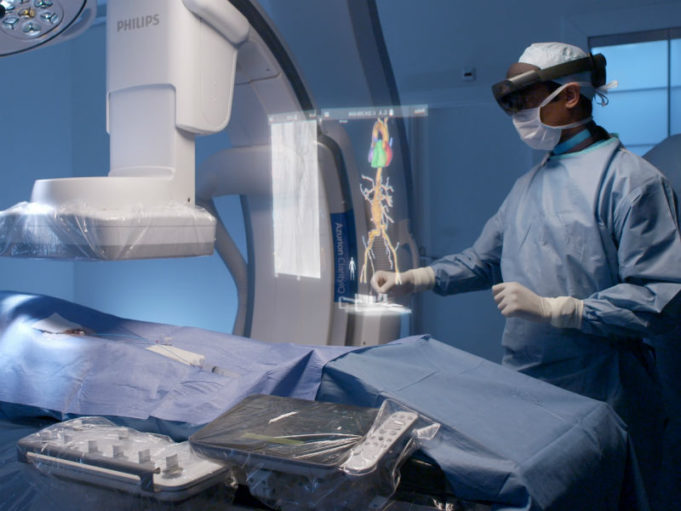At the MWC (25–26 February, Barcelona, Spain), formerly the Mobile World Congress, Philips unveiled a unique mixed reality concept developed in partnership with Microsoft for the operating room of the future. Based on Philips’ Azurion image-guided therapy platform and Microsoft’s HoloLens 2 holographic computing platform, the companies will showcase novel augmented reality applications for image-guided minimally invasive therapies. The technology allows wearers of the HoloLens 2 headset to access a virtual screen displaying data from the Azurion system, updated in real time, during procedures.
The Philips and Microsoft augmented reality concept, built for HoloLens 2, brings live imaging and other sources of vital data currently displayed on large 2D screens into a 3D holographic augmented reality environment that can be ergonomically, easily and intuitively controlled by the physician. The concept is being used to gather further clinical insights to support the development of future commercially-available augmented reality solutions for use in image-guided procedures.
“The transition from open surgery to image-guided procedures has driven a seismic shift in improving patient outcomes and reducing costs—not least by dramatically reducing the length of time a patient stays in a hospital after their procedure,” said Atul Gupta, chief medical officer for Image Guided Therapy at Philips and a practicing interventional and diagnostic radiologist.
“On our Azurion platform we seamlessly integrate a range of data sources in a way that is intuitive to understand and control. By collaborating with Microsoft and HoloLens 2 we can take it to the next level, immersing the physician in a tailored augmented reality environment. This concept allows me to see the real world superimposed with the live data and 3D medical imagery needed to guide our precision therapy, and importantly also lets me control Azurion with voice recognition, eye tracking and advanced gestures. It is all about keeping our focus on the patient.”
“Mixed reality is giving people new ways to interact with the digital and physical world, bringing the benefits of the digital revolution to entirely new experiences across the globe,” said Alex Kipman, technical fellow, AI and Mixed Reality at Microsoft. “I am thrilled to see companies in a broad range of industries achieve more using the products that we build with our partners and ecosystem. Mixed reality holds great potential in healthcare, and our collaboration with Philips shows how that potential is already beginning to be realised.”
Microsoft unveiled HoloLens 2 during the previous day of the conference. HoloLens is a self-contained holographic computer that enables hands-free, heads-up interaction with three-dimensional digital objects.
Since its global launch in February 2017, over half a million patients have been treated in more than 80 countries using the Azurion platform, which is powered by Philips’ proprietary ConnectOS and combines technical innovations in both software and hardware. ConnectOS allows the integration of advanced digital innovations on the Azurion platform.

